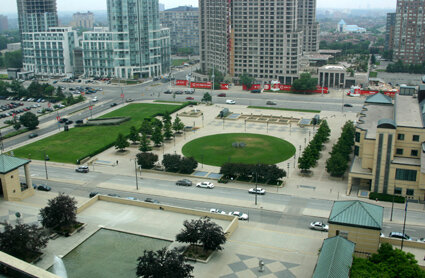I find the comparison between hardware and software very useful when thinking and talking about public realm projects and urban development. It seems that urban planning, design and development have been almost fully oriented to building hardware, and there has only recently been acknowledgement that without software you’re going to have pretty disappointing results.
Placemaking, of course, has been one of the leading movements to push this concept, although it hasn’t made use of the software/hardware analogy. But placemaking does go back to function, programming public spaces, making sure that activation and management take the place they deserve alongside design and construction.
Looking around your community, you can probably find many, many examples of expensive hardware that underperforms simply because nobody budgeted for actually programming and using that hardware to its full potential. I find it sad because it’s such a rampant phenomenon and costs us so much: 1) in the original capital expenditure; 2) in the loss of ROI that could be captured if the programming side were properly matched to the capital investment, and; 3) in the missed opportunities to improve our lives!
There are so many urban spaces that are literally just hardware sitting around with no purpose. Think of your average civic plaza as a perfect example – it’s so often a hardscape that sets off the architecture of a city hall or courthouse complex. But the plazas around the buildings typically have zero purpose and no one goes there.
Urban Spaces Are Outdoor Community Centers
This is a terrible waste of money. Instead, we should emulate the better examples in our communities like libraries and community centers. These are facilities that really are driven by the programming that goes on inside of them and hopefully have the support staff to effectively maintain those programs at a high standard. I worked on a project with Gil Penalosa in Mississauga many years ago, and he made the point about how our urban parks and plazas should be considered — and funded — as “outdoor community centers.” At that time, Mississauga’s civic center plazas had no programming or operations budget, and no dedicated staff, whereas there were at least 30 well-staffed community centers in the city with vibrant programming. That analogy helps crystallize that the programming and staffing is at the heart of it – the utility to the community is the main purpose for our urban spaces, and that the space makes no sense without having the staffing, programming, and operations budget.
Fortunately for Mississauga, a fast-growing city of 750,000, they listened. The previously moribund plazas surrounding the city hall/library complex are now known as Celebration Square, a heavily programmed space that offers more than 150 free event days and festivals throughout the year and that has helped to redefine the center of this suburban city.


Mississauga Civic Centre in 2006 (looking south) vs. its re-launch as Celebration Square (looking north). Photo credit: Naeem Jaffer
Breathe New Life Into Downtown
If you want to breathe new life into a facility or downtown, don’t spend all your money on capital projects. Rather, spend half that money on the staff and programs that attract people, enliven it, improve bodies and minds, and actually put the facility to its best use.
“design is how it works, not how it looks.” – Steve Jobs
I think about all the urban development that goes on, the rise of innovation districts, medical districts, and other mixed-use districts, and how the vast majority of the bets being made are made on the success or failure of the hardware. If you complete our analogy and think of how product development works in computing and tech, it’s almost the opposite. The software engineers are leading development, designing apps that have utility, and the best possible user interface. As Steve Jobs said, “Design is how it works, not how it looks.” Ultimately Apple’s products look great too, but there is a full integration of the hardware and the software. Where is that mindset in the urban development and design process?
Placemaking and development blog RSS


